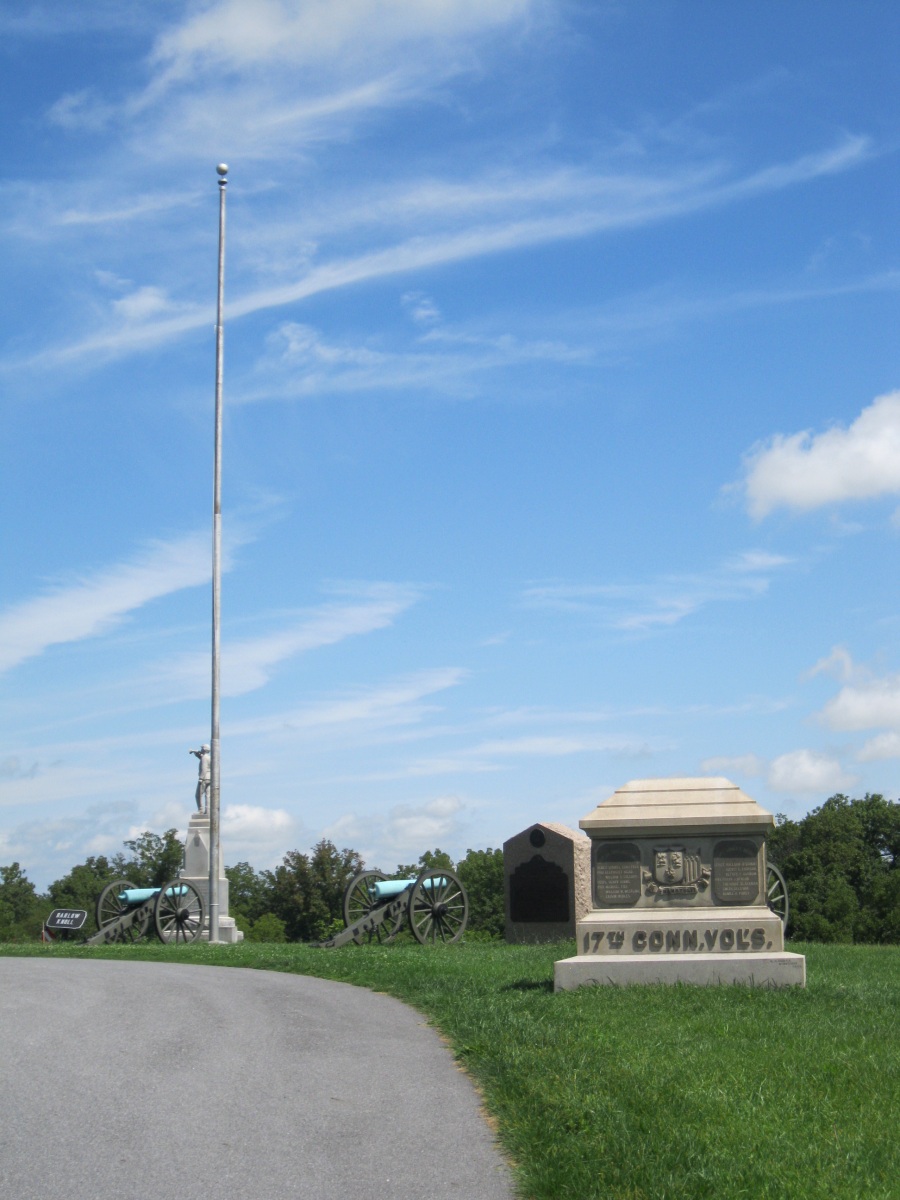
Barlow’s Knoll at Gettysburg. The monument marks the location where Captain James Moore of Company C was killed. The flagpole was erected on the location where Lt. Colonel Douglass Fowler died.
150 years ago, on a small rise north of Gettysburg, the 17th CVI lost their 2nd lieutenant colonel in as many battles. Those who visit Gettysburg find 2 monuments on Barlow’s Knoll – or as it was known then, Blocher’s Knoll. The first is the large monument dedicated in 1884. The 2nd, missed more than one might expect, is the flagpole just beyond it. The flagpole (not the original, which blew down in the late 19th century) marks the spot where Lt. Colonel Douglass Fowler lost his life on July 1st.
Accounts left by veterans of the 17th mention how conspicuous Fowler was, riding his white horse among his troops as they advanced to the crest of the knoll. No doubt he presented far more of a target than anyone would have liked. While the regiment lay in the fields south of the knoll, enduring the artillery fire of the leading Confederate batterirs, he calmed their nerves, shouting “Dodge the big ones, boys!” Then, leading the remaining companies of the regiment (4 companies had advanced to the Benner Farm) forward to the knoll, Fowler yelled ““Now, Seventeenth, do your duty! Forward, double quick! Charge bayonets!” as he rode forward.
The reasons for his being so visible, according to some of his men, was in part because he had been too ill too march with the regiment at Chancellorsville. His promotion over Major Allen Brady, while approved of by most of the regiment, was not to the liking of Brady, who insinuated (and more) that Fowler was not the soldier that Brady was – pointing to Chancellorsville as his proof. Perhaps Fowler felt he had something to prove at Gettysburg. Perhaps it was just his style of leadership.
No one will ever know.
It was not long afterwards that Fowler fell from his horse, dead from either a gunshot wound to the head or from an artillery shell (accounts vary from a clean hole to near-decapitation). No matter how it occurred, the regiment lost one of, if not the most, beloved officer in the regiment at the worst possible moment.
There is no need to go into the details of the first day’s fight for the 17th CVI – that story is told in other places on this site and in the words of those who fought there. What is clear is that the loss of Fowler, in addition to the loss of Captain James E. Moore of Company C, made a significant impact on the survivors of the battle. The monument sits on the spot where Moore was killed, the flagpole where Fowler died.
After the battle Moore’s body was recovered for burial. Not so with Fowler. His men made an effort to bring his body off the field in the face of oncoming Confederates, but they could not. Prisoners from the 17th saw his body was stripped of clothing soon after. . By all accounts he was buried in a mass grave near the spot he was killed and, despite being a big man, his head wound made it impossible to identify his body after the battle. The veterans of the regiment did not give up their efforts to recover Fowler’s body (or Charles Walter’s body at Chancellorsville, for that matter). They made repeated inquiries and visits to the field without success.
Somewhere in the Gettysburg National Cemetery, under one of the many stones without a name, lies the body of Douglass Fowler, who died on July 1, 1863. The next time you are on Barlow’s Knoll, standing by the flagpole, remember the big man on a white horse who, as he urged his men to forward, died while doing his duty.
